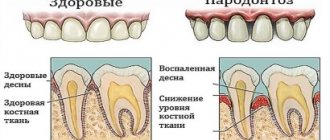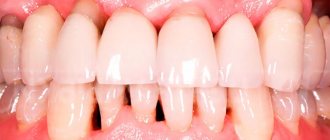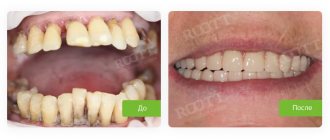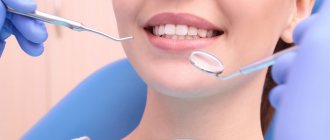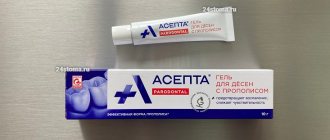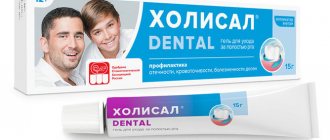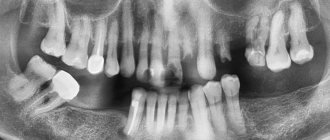Symptoms of periodontitis (photo), treatment and prevention
Periodontitis is a dental disease, inflammation of the gums. The term periodontium is used to collectively refer to the tissues that surround a tooth and hold it in the jaw. These are ligamentous fibers, connections between the mucosal surface and the crown, gingival cement and gingival bone.
The causes of periodontitis lie in infection of the gums through dental tissue (caries, plaque), dental pockets (gingivitis) or from internal sources of infection (internal inflammatory diseases). Let's look at the symptoms and signs of periodontitis, methods of its treatment and prevention.
Periodontitis and periodontal disease - what is the difference?
Often patients consider these two concepts to be the same dental disease, but this is not entirely true. With periodontitis, there is always an active inflammatory reaction, bleeding and swelling of the gums, periodontal pockets of varying depths and tooth mobility. With periodontal disease, the gums are dense, anemic, there are no pockets or tooth mobility, but the necks and roots are significantly exposed, as a result of which wedge-shaped defects often appear in these areas.
Nature of the disease
Periodontitis is an acute inflammatory reaction in the gum tissue, and periodontal disease is the internal depletion and thinning of the periodontium.
Causes of diseases
Periodontitis occurs due to the penetration of pathogenic microbes into the gum tissue. This can be caused by poor oral care, non-compliance with hygiene rules, mechanical damage to the jaw, teeth and gums, or incorrectly installed dentures and implants.
The causes of periodontal disease are more difficult to establish: it may be a hereditary predisposition, the consequences of trauma to the gums and teeth, vitamin deficiency, and impaired vascular function in the tissues surrounding the teeth. Periodontal disease also develops against the background of chronic diseases of the body (for example, diabetes, diseases of the digestive system, etc.), and also often appears during pregnancy.
Why does periodontitis develop?
Chronic localized periodontitis can appear for several reasons:
- The presence of carious cavities on the proximal side of the tooth.
- Inadequate prosthetics, after which wide crowns, incorrectly manufactured removable or bridge dentures injure the gums.
- Trauma to the gums as a result of physical impact (bruise) or malocclusion (creation of so-called supraocclusion). If the teeth do not close evenly and there is an area where biting occurs first (super contact), due to the increased load, periodontal inflammation develops in this area. The cause of supercontact may be a filling that overestimates the bite or the absence of part of the teeth.
- Unprofessional dental treatment, as a result of which fillings were installed that do not correspond to the anatomical shape of the tooth, as a result of which overhanging edges injure the edge of the gums and cause food retention in the spaces between the teeth, which leads to the development of the inflammatory process.
The causes and factors that provoke the development of a generalized inflammatory process in the periodontium are as follows:
- Impaired functioning of the immune system, leading to a decrease in the general and local protective response of the body;
- Poor oral hygiene, leading to the accumulation and activation of pathogenic microorganisms;
- Violation of the rate of metabolic processes in the periodontium;
- Reduced load on the dentogingival apparatus due to eating predominantly soft foods;
- Abnormal bite or incorrect location of individual teeth in a row (shifts and rotations along the axis);
- The presence of certain diseases (atherosclerosis, diabetes, gastrointestinal diseases);
- Exposure to occupational (chemicals) or environmental (increased background radiation) harmful effects, constant stress;
- Bad habits, unbalanced diet, excessive use of certain drugs;
- Pregnancy period (the first place at this time is the change in hormonal levels);
- Hereditary predisposition.
Acute periodontitis develops mainly after injuries - chemical (the effect of various substances on periodontal tissue), physical (thermal burns), extensive mechanical damage. This form of the disease can also develop as a complication of acute necrotizing ulcerative gingivitis.
Classification of periodontitis
The most effective treatment for periodontitis can be chosen when its form is accurately diagnosed. Classification of types of disease is carried out according to the severity of its symptoms, the presence of complications and consequences of the development of periodontitis.
Based on the form of the disease, the following types of disease are distinguished:
1. An acute form of periodontitis, in which the process of inflammation in the periodontium develops at a rapid pace and can cause the appearance of abscesses and fistulas.
2. Chronic periodontitis is asymptomatic and its development is slow. The disease may not show itself in any way, but tissue destruction will still occur, and therefore it is so important to diagnose the disease in a timely manner and begin treatment of chronic periodontitis.
According to the area of manifestation, periodontitis is graded into the following types:
1. Localized periodontitis. This type of disease arises mainly from gum trauma and responds well to treatment.
2. Generalized periodontitis. Treatment of generalized periodontitis is a complex and lengthy process, since the disease spreads to a significant part of the periodontium.
Periodontitis is also classified according to the stages of its development and the appearance of various complications that arise due to improper or late treatment of the disease. It is important to understand that only a qualified doctor can correctly diagnose the type of periodontitis and choose a method of treatment. In our clinic in Moscow, Vanstom, innovative methods and means are used to diagnose and treat periodontitis. Come to us for your dental health! Address of our clinic: Moscow, Baumanskaya metro station, st. Bakuninskaya, 17/28.
Symptoms
Periodontitis (see photo) is manifested by the progressive destruction of the alveolar processes (namely, the dental cells of these processes). The symptoms of the initial stages are scanty - bleeding gums, loose teeth, sometimes viscous saliva, plaque on the teeth. When the disease is active, due to the rapid destruction of the alveolar processes, the teeth gradually fall out.
The clinical manifestations of exacerbation of periodontitis are more varied: inflammation of the gums, purulent discharge from the periodontal pockets, bad breath, pathological mobility of teeth, and their displacement. Abscesses and fistulas on the gums, enlargement and soreness of the submandibular lymph nodes are common. A chronic course with frequent exacerbations of periodontitis may be accompanied by microbial allergies.
Stages of the disease
In dentistry, there are three stages of periodontitis:
- Grade 1 is a small depth of periodontal pockets (up to 3 mm), the appearance of periodic bleeding of the gums after cleaning. At this stage there is no pain or tooth mobility.
- 2nd degree - the pockets deepen up to 5 mm, the neck of the tooth is partially exposed, and a feeling of discomfort appears when in contact with cold and hot.
- Stage 3 is formed 4-5 years after the onset of inflammation (with the usual non-aggressive course of the disease). With severe gum damage, the pockets deepen beyond 6 mm, usually accompanied by the accumulation of food debris and the formation of pus. Pus comes out from under the tooth when you press on the gum. The teeth themselves become very loose and exposed.
Classification of the degree of tooth mobility:
- 1st degree. It is characterized by the possibility of tooth displacement by no more than one millimeter in the vestibulo-oral, bucco-lingual directions and to the adjacent tooth;
- 2nd degree – pathological mobility in the same directions by more than a millimeter, and the appearance of mobility in the palatal-distal direction;
- 3rd degree – teeth are mobile in all directions, including vertical. If some neighboring teeth are missing, then tilting is possible;
- 4th degree – the tooth is mobile in all directions, easily makes any forced movements, including around its axis.
In addition, there are several more varieties of the course of the disease. If gum inflammation develops very quickly, deep pockets up to 8-10 mm deep are formed in one to two months, then this is aggressive periodontitis. If the disease affects several teeth, then it is local periodontitis.
Symptoms of chronic periodontitis:
But in almost all cases, patients turn to the periodontist precisely with chronic generalized inflammation of the gums, and the medical history is always the same. First, insufficient oral hygiene leads to the accumulation of microbial plaque on the teeth, pathogenic bacteria in which produce “toxins” that trigger inflammation in the gums. At first, the inflammation is only superficial in nature, and is manifested by bleeding and pain when brushing teeth, as well as swelling, redness or cyanosis of the gingival margin.
At this stage, there is still no destruction of the periodontal attachment, destruction of bone tissue or destruction of periodontal fibers, due to which the tooth is attached to the bone tissue. This inflammation of the gums is called catarrhal gingivitis. If it is treated incorrectly or untreated, gingivitis sooner or later transforms into the next form of gum inflammation, i.e. in periodontitis. The starting point for the development of periodontitis is the destruction of the dentogingival attachment (i.e., the attachment of soft gum tissue to the neck of the teeth).
The dentogingival (enamel) attachment is an anatomical barrier that prevents the penetration of pathogenic bacteria below the gum level. As soon as this barrier is destroyed, inflammation affects not only the soft gum tissue, but also bone tissue, as well as periodontal fibers, due to which the tooth root is attached to the bone tissue. This leads to their gradual destruction. Symptoms and treatment of periodontitis will depend on its severity (i.e., the degree of destruction of the tissue around the teeth). There are mild, moderate and severe forms of this disease.
Mild periodontitis –
With a mild form of periodontitis, firstly, all the symptoms of catarrhal gingivitis will persist, i.e. the patient will continue to complain of occasional pain and bleeding when brushing teeth. In addition, swelling, bluishness or redness of the gingival margin will continue to be observed, as well as accumulations of microbial plaque or tartar in the area of the necks of the teeth (Fig. 4-5).
What periodontitis looks like: photo
The main diagnostic criterion that distinguishes the symptoms of the initial stage of periodontitis from the symptoms of catarrhal gingivitis is the formation of periodontal pockets (gingival pockets) - up to 3.5 mm deep. Such pockets are formed due to the destruction of the attachment of soft gum tissue to the necks of the teeth, which leads to the penetration of pathogenic bacteria below the gum level. As soon as this happens, inflammation and pathogenic bacteria lead to the destruction of periodontal tissue and bone tissue near the tooth root (Fig. 6).
On the surface of the tooth root (in the depths of the periodontal pocket) there are hard dental deposits, and the lumen of the pocket is filled with serous-purulent discharge. During a period of decreased immunity, the patient may notice that purulent discharge may be released from the periodontal pockets - this becomes especially noticeable when pressing on the gums in the projection of the periodontal pocket. In patients with this stage of periodontitis, a panoramic radiograph shows a decrease in the level of bone tissue (interdental septa) - up to 1/3 of the length of the roots of the teeth, and there may be 2 types of inflammatory bone resorption:
- Horizontal bone resorption is typical for elderly and relatively elderly people; the disease usually progresses slowly (with a uniform decrease in the height of bone tissue in the area of all teeth). Thus, in this group of patients, periodontal pockets with a depth of 3.0-3.5 mm may sometimes not be visible, but there is a uniform decrease in bone level in the area of all teeth.
- Vertical bone resorption is typical for young and relatively young people. The nature of the inflammation is usually aggressive (with rapid progression). Bone destruction occurs only in the area of periodontal pockets that form along the surfaces of the roots of the teeth. At the same time, as such, a decrease in the height of the interdental bone septa is not observed. This form is the most difficult to treat.
Important: with mild periodontitis, tooth mobility is not yet observed, as well as their displacement under the influence of chewing pressure (all this is typical for moderate and especially severe periodontitis).
Moderate periodontitis –
This stage of the inflammatory process is distinguished by the fact that the number of periodontal pockets increases significantly, and their depth can already reach 5.0 mm. An increase in the depth of the pockets creates excellent conditions for the proliferation of pathogenic pyogenic bacteria, and therefore the release of serous-purulent exudate from the pockets becomes rather the norm (which is especially visible when pressing on the gums in the projection of the periodontal pocket). In addition to pathogenic bacteria, periodontal pockets at this stage may also contain fungal flora, which is important in the choice of drugs for the treatment of periodontitis.
An increase in the depth of periodontal pockets to 5.0 mm means a decrease in bone level by approximately 1/3-1/2 of the length of the roots. Visually, this can be expressed in a decrease in the gingival margin relative to the necks of the teeth, i.e. Root exposure may already be occurring. In addition, with such a degree of bone destruction, 1) mobility of teeth of 1-2 degrees occurs, 2) tilting of some teeth may appear, 3) fan-shaped discrepancy of the front teeth may begin to appear. The latter is especially typical for patients with the absence of a large number of lateral chewing teeth.
Moderate periodontitis –
At this stage of inflammation, patients often complain of a deterioration in their general condition - increased fatigue, weakness, and a decrease in immunity + frequent colds. This is due to the fact that serous-purulent discharge is always present in periodontal pockets, from which toxins and pathogens are absorbed into the blood and spread throughout the body, affecting primarily the immune system.
Very important: once again we draw your attention to the fact that at this stage of periodontitis, “secondary deformations of the dentition” already occur, i.e. the teeth begin to “move apart” (changing their position depending on the direction of the usual chewing pressure). Therefore, the treatment of moderate periodontitis is already much more complex - in comparison with mild periodontitis, and will require you to spend quite a lot of money on splinting and prosthetic teeth. Therefore, it is important not to bring it to such a state, and not to self-medicate (24stoma.ru).
Severe periodontitis -
Severe periodontitis is characterized by further deterioration of all symptoms. The depth of periodontal pockets can already reach 6.0 or more. Accordingly, the decrease in the level of bone tissue in the area of the interdental septa reaches 2/3 or more of the root length. Mobility is observed in most teeth, and in some teeth it already reaches 3-4 degrees. With this severity of periodontitis, exacerbations of the inflammatory process often occur, which are accompanied by the formation of abscesses, sharp swelling of the gums, pain in them, and a sharp increase in tooth mobility.
Severe periodontitis: photo
It should be noted that in severe cases, patients begin to suffer not only from local symptoms in the oral cavity, but also complain of weakness, malaise, poor sleep, and appetite. Severe chronic inflammation of the gums can also affect the frequency of exacerbations of chronic diseases of the internal organs. The condition of patients with diabetes mellitus, cardiovascular, hormonal, and rheumatoid diseases is especially deteriorating.
Exacerbation of periodontitis – there is also such a thing as “course of the disease”. As a rule, periodontitis is characterized by a sluggish chronic course, i.e. when the symptoms are smoothed out (there are no acute phenomena of inflammation), but exacerbations of the inflammatory process may periodically occur. During exacerbations, the symptoms become much more pronounced - tooth mobility and bleeding gums increase, swelling of the gums and the formation of purulent abscesses may occur, and purulent discharge from periodontal pockets may also appear. The development of exacerbation may be associated both with the depletion of local protective mechanisms of the oral cavity and with a decrease in the body's immunity. Next, we will talk about how to treat periodontitis.
Diagnostics
If any symptoms of periodontitis are detected, it is important to promptly consult a dentist and undergo a thorough examination, during which a specialist will be able to make the correct diagnosis or prescribe additional tests to differentiate the disease.
During the examination, the dentist will perform probing, which will help determine the depth of the gap between the gum and tooth. Based on the results of the examination, it will be possible to determine the degree of periodontitis.
Additional studies are prescribed:
- benzidine test (helps determine the presence of pus in the periodontal pocket);
- Schiller-Pisarev test (helps to see the inflammatory process in the gums at an early stage due to staining);
- radiography (to visualize the degree of bone tissue destruction);
- a smear from a periodontal pocket (determines causative bacteria);
- panoramic tomography (a full view of the affected jaw, mainly prescribed for suspected generalized periodontitis).
In cases where periodontitis is accompanied by general diseases, other tests may be prescribed to help determine the diagnosis and prescribe appropriate treatment.
Periodontal diseases. What gum diseases are there?
Notice
: Undefined variable: post_id in
/home/c/ch75405/public_html/wp-content/themes/UltraSmile/single-item.php
on line
45 Notice
: Undefined variable: full in
/home/c/ch75405/public_html/wp-content /themes/UltraSmile/single-item.php
on line
46
Rate this article:
( 2 ratings, average: 3.00 out of 5)
gum disease
1 Beloklitskaya G.F. Clinical forms of generalized periodontitis and their significance for its differentiated therapy.
How to treat periodontitis?
Effective treatment of this disease will largely depend on how far the inflammatory process has progressed. The more significant the level of bone loss around the teeth, the degree of tooth mobility, the more teeth were lost - the more difficult, longer and more expensive the treatment will be.
The first thing to do is make a treatment plan. This is not as easy to do as it might seem in reality. If the disease is mild, you may only need to consult a periodontist. In cases where the disease is severe, there are malocclusions, there are missing teeth or teeth that need to be removed during treatment, a joint consultation with a periodontist, an orthopedist (prosthetist) and a general dentist is necessary. Remember that it is necessary to plan prosthetics and dental treatment before the actual periodontal treatment begins.
The next stage is direct work with the gums, or rather deposits on the gums. As is known, a significant percentage of periodontitis depends on non-compliance with oral hygiene, namely incomplete cleaning of the area where the gums adhere to the tooth. As a result of this, dental plaque and subsequently tartar are formed, which contribute to the separation of the gums from the tooth itself.
Until dental plaque is removed, no treatment method will bring the expected result, and time will be wasted. Therefore, at the second stage, dentists begin to cleanse the oral cavity of plaque and tartar. This procedure is best carried out using the ultrasound method.
Periodontitis and periodontitis: are they the same thing or not?
Despite sounding similar, periodontitis and periodontitis are two completely different diseases. They are provoked by various factors and differ in symptoms, consequences for the body, and approach to treatment.
Understanding the difference between periodontal and periodontal disease will help to understand the nature of these diseases.
- Periodontium is a complex of soft and hard tissues that hold the tooth in the alveolus (tooth socket). It includes the gums, tooth cement, periodontal ligaments, periosteum, and bone tissue of the alveolar process.
- The periodontium is a layer of connective tissue that is located between the cement of the tooth root and the bone layer of the alveolar ridge.
That is, the periodontium is the entire supporting and retaining apparatus of the teeth, while the periodontium is one of its components.
Drug treatment
Drug treatment of periodontitis can be divided into local and general:
- General therapy. A combination of antibiotics is prescribed. Moreover, depending on the severity of inflammation and the presence of concomitant diseases, antibiotics can be prescribed both in tablets and intramuscular injections (which, by the way, is preferable). Treatment of periodontitis with antibiotics is also carried out for 10 days, no less.
- Local therapy (in the oral cavity). It includes antiseptic mouth rinses, rinsing periodontal pockets from a syringe with antiseptic solutions, and applications of antimicrobial anti-inflammatory gels. The duration of local anti-inflammatory therapy is 10 days, treatment is carried out twice a day (morning and evening). Moreover, depending on the severity of the disease, the periodontist may prescribe rinses and applications for home use, or you will need to come to the dental clinic at least once a day. In this case, the doctor will rinse the periodontal pockets with antiseptic solutions from a syringe and also treat the gums with gel. The patient will have to do the second treatment independently at home.
- Physiotherapy. Local therapy may also include physical therapy. For example, laser treatment of periodontitis has recently been advertised. But you need to understand that treatment of periodontitis with laser or electrophoresis is only an auxiliary physiotherapeutic method that allows you to relieve the symptoms of inflammation only a little faster.
- Toothpastes. Special anti-inflammatory toothpastes can be an additional tool in complex treatment. There are very good pastes that will help quickly relieve inflammation and strengthen the gums.
In parallel with the removal of dental plaque and anti-inflammatory therapy, it is necessary to begin treatment of carious teeth and removal of non-viable teeth. If at the stage of drawing up a treatment plan the need for prosthetics with bridges or removable dentures was determined, then at this stage the teeth can be prepared for prosthetics, for example, tooth depulpation.
Rehabilitation after treatment of periodontal diseases.
The importance of a doctor’s recommendations cannot be underestimated, because the effectiveness of even the most modern treatment of periodontal disease and periodontitis largely depends on proper oral hygiene. Only daily brushing of teeth and caring for gums will help get rid of plaque and avoid the appearance of tartar. Massaging with the right toothbrush will have a beneficial effect on your gums, and using medicated toothpastes recommended by your doctor will protect against irritation. The periodontist at the LeaderStom clinic will tell you in detail about toothbrushes, how to choose the right toothpaste and what products to use to reliably protect the gum tissue.
If dental health is important to you and you dream of a snow-white, dazzling smile, feel free to contact Leaderstom: prices for treatment of gums, teeth, periodontitis and periodontal disease will invariably please you, and doctors will make the treatment procedure comfortable and painless. We will conduct a preventive examination, advise and help you choose oral care products, perform professional teeth cleaning and cure gum disease. New products in the field of dental equipment and doctors who have many years of experience, advanced training courses and thousands of treated teeth and gums will help with this.
Treatment of periodontitis with folk remedies
In some cases, drug treatment is replaced with alternative medicine recipes.
The following recipes can be used at home:
- Fresh plantain juice. It rubs into the gums.
- Oak bark (two tbsp) and linden flowers (one tbsp). Mix, pour a large spoonful of the composition into a glass of boiling water. Cool, after straining, use as a mouth rinse 4-5 times a day.
- Sea buckthorn and fir oils. Equal parts of oils are mixed, a piece of bandage is soaked in the mixture, and the sore spot on the gum is massaged with it for ten minutes twice a day.
- Comfrey roots. One tablespoon of roots (crushed, dry) is poured into a glass of water and boiled over medium heat for 20 minutes. Use the decoction as a rinse twice a day.
- Juices of agave (aloe) or Kalanchoe. Make lotions with juices every 10 days, applying to the sore gum for 35 minutes.
Only after consultation with a doctor is it possible to use “grandmother’s recipes”, since the main principle of treating periodontitis remains the principle of not doing harm and not getting a complicated course of the disease.
Is it possible to treat periodontitis at home?
Many patients ask the question: can treating periodontitis with folk remedies be effective? Experts give a clear answer to this question: it is impossible to cure periodontitis at home, since even potent pharmaceutical drugs are sometimes ineffective against this disease. The inflammatory process develops in the deep layers of tissue and therefore neither decoctions nor herbal infusions can stop it.
Some folk recipes can make periodontitis therapy faster, but before using them, you should definitely consult with the specialist leading your treatment. Using folk recipes on your own is simply dangerous, since they may not only not help, but also aggravate the situation. For example, some traditional healers advise making hot compresses, but heating the area of inflammation means catalyzing the process of its development. Therefore, do not waste time treating periodontitis with folk remedies. The most effective treatment for this disease is complex therapy carried out by competent specialists and in a clinical setting.
Surgery
As soon as the teeth become mobile, the dentist resorts to a treatment method such as splinting. With its help, the load is distributed from mobile teeth to stable ones.
There are three splinting methods:
- In the first case, when splinting, a horizontal bar and fiberglass tape are placed on several teeth, after which everything is filled with a light composite. This bar strengthens mobile teeth, stabilizing the row.
- Crowns are considered a more effective method. To do this, the upper part of the tooth is ground down and the root is filled. Crowns soldered together are placed on top. The material for crowns can be chosen depending on preferences and financial capabilities.
- The most expensive and most effective is the use of a clasp prosthesis. It is placed on the jaw and is additionally secured with a metal crossbar for greater stability.
Gingivectomy:
- Gingivectomy is usually used in the early stages of the disease. The essence of the operation is to clean the pockets and remove the inflamed areas of the gums by making an incision. The wound is treated with a special solution and filled with iodine. As a rule, gingivectomy is prescribed for complex surgery in the area of several teeth. The procedure is often confused with patch surgery.
Gingivoplasty:
- For periodontitis, gingivoplasty may be prescribed. It is necessary not only for aesthetic reasons, but also for cleaning pockets and restoring them. The operation is performed under local anesthesia after pre-treatment with an antiseptic. The dentist cleans the contents of the pockets, removes caries and tartar from the roots, and covers the cement of the tooth with a protective film. The gingival tissue is renewed with epithelium taken from the palatal part. Often, during gingivoplasty, bone tissue is restored or transplanted.
Flap operation:
- It can be carried out in several ways, but its main goal is to cleanse the roots of dangerous plaque and secure the gums in such a way as to hide the roots as much as possible. The surgical intervention takes place under local anesthesia, the dentist makes an incision into the tissue, performs root sanitation and puts the flaps back. Often, areas of the gum damaged by inflammation are removed. The pieces of epithelium are connected with sutures.
Prosthetics are performed for patients with missing teeth in the dentition. This is the final stage of treatment, before which the oral cavity was sanitized and gum inflammation, caries, etc. were eliminated. The purpose of this stage is to restore chewing function and correctly distribute the load on the patient’s healthy teeth, prevent their displacement, and restore the aesthetics of the oral cavity. In order to relieve the burden on the teeth before surgery, it is necessary to resolve the issue of prosthetics - install at least a temporary prosthesis for this period, which is subsequently replaced with a better one. Otherwise, after surgery, tooth mobility will only increase.
What is periodontal disease: symptoms
The disease in question is accompanied by severe symptoms only in the rarest cases, so it is much more difficult to diagnose, especially in the early stages of development. At the moment, the exact causes of the disease have not been established. Periodontal disease, as a rule, is generalized, that is, it covers the entire oral cavity of the patient.
In some cases, bleeding gums and loose teeth may develop. More often, patients experience itching and burning of the oral tissues.
Periodontal disease is difficult to treat and requires lifelong monitoring by a specialist. In the presence of a purulent form of the disease, surgical treatment is often resorted to.
Prevention
To prevent such serious problems with soft tissues, it is best to stick to simple and accessible methods of prevention. Dentists recommend:
- avoid stressful situations;
- eat well and strengthen the immune system;
- do not cause general diseases;
- if even one unit falls out, install prostheses;
- lead a healthy lifestyle and give up bad habits;
- try not to damage soft tissues with sharp objects, avoid traumatic situations;
- treat any diseases in a timely manner and eliminate the first symptoms;
- Brush your teeth daily with a medium-hard brush, in circular motions, for at least five minutes;
- If a malocclusion is detected in childhood, it is better to correct it.
- do not forget about the importance of solid products that stimulate metabolic processes in the gums and naturally cleanse the surface of plaque;
- visit the dental office every six months for a thorough examination and detection of the first signs of any abnormalities, as well as for professional cleaning of plaque and tartar.
In addition to these general tips for maintaining health and maintaining good oral hygiene, you can also periodically massage your gums. To do this, apply light pressure on both sides with clean fingers. It is not difficult, and the whole procedure lasts no longer than 5-10 minutes. As a result, metabolic processes in periodontal tissues will resist the proliferation of bacteria.
A few words about the importance of periodontitis prevention
Treatment of periodontitis is a complex and lengthy process, sometimes it can last for several years. And naturally, carrying out the necessary procedures will require you not only time, but also significant financial expenses. Both time and money costs can be avoided if you prevent the development of periodontitis.
To effectively prevent the development of periodontitis, dentists advise following the following simple recommendations:
1. Regularly carry out high-quality dental and oral hygiene at home and from time to time - professional teeth cleaning in dentistry.
2. Contact the dental clinic at the first signs of not only periodontitis, but also caries, and undergo treatment on time.
3. Monitor your diet: it must be balanced and your menu must contain foods containing vitamins and minerals.
4. If you lose even one tooth, do not postpone the prosthetic procedure.
5. Regularly undergo preventive examinations at the dentist.
Also, for effective prevention of periodontitis, you should avoid stressful conditions, strengthen the body’s immune system, and protect your gums from injury. Follow these simple rules, and then you won’t have to waste time and money on periodontitis treatment.
Calculate the cost of treatment by taking a short test in 20 seconds!
Do not delay your treatment, because in this matter time plays against us.
